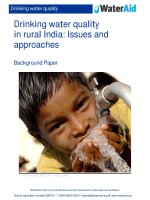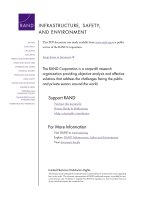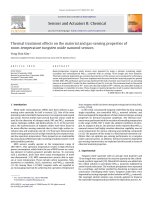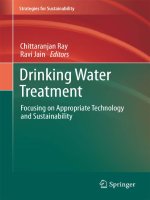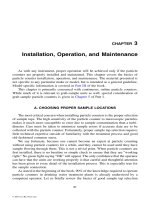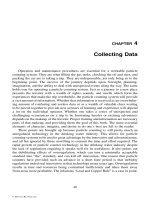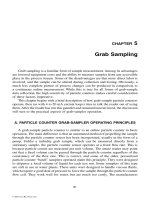drinking water treatment focusing on appropriate technology and sustainability
Bạn đang xem bản rút gọn của tài liệu. Xem và tải ngay bản đầy đủ của tài liệu tại đây (4.32 MB, 280 trang )
Strategies for Sustainability
Series Editors
Lawrence Susskind
Ravi Jain
For further volumes:
/>Strategies for Sustainability
Aims and Scope
The series, will focus on “implementation strategies and responses” to environmen-
tal problems – at the local, national, and global levels. Our objective is to encour-
age policy proposals and prescriptive thinking on topics such as: the management
of sustainability (i.e. environment-development trade-offs), pollution prevention,
clean technologies, multilateral treaty-making, harmonization of environmental
standards, the role of scientific analysis in decision-making, the implementation of
public-private partnerships for resource management, regulatory enforcement, and
approaches to meeting inter-generational obligations regarding the management
of common resources. We will favour trans-disciplinary perspectives and analy-
ses grounded in careful, comparative studies of practice, demonstrations, or policy
reforms. We will not be interested in further documentation of problems, prescrip-
tive pieces that are not grounded in practice, or environmental studies. Philosophi-
cally, we will adopt an open-minded pragmatism – “show us what works and why”
– rather than a particular bias toward a theory of the liberal state (i.e. “command-
and-control”) or a theory of markets.
We invite Authors to submit manuscripts that:
Prescribe how to do better at incorporating concerns about sustainability into public
policy and private action.
Document what has and has not worked in practice.
Describe what should be tried next to promote greater sustainability in natural
resource management, energy production, housing design and development, indus-
trial reorganization, infrastructure planning, land use, and business strategy.
Develop implementation strategies and examine the effectiveness of specific sus-
tainability strategies. Focus on trans-disciplinary analyses grounded in careful, com-
parative studies of practice or policy reform.
Provide an approach “…to meeting the needs of the present without compromising
the ability of future generations to meet their own needs,” and do this in a way that
balances the goal of economic development with due consideration for environmen-
tal protection, social progress, and individual rights.
The Series Editors welcome any comments and suggestions for future volumes
SERIES EDITORS
Lawrence Susskind
Professor Ravi Jain
Chittaranjan Ray • Ravi Jain
Editors
Drinking Water Treatment
Focusing on Appropriate Technology
and
Sustainability
1 3
ISBN 978-94-007-1103-7 e-ISBN 978-94-007-1104-4
DOI 10.1007/978-94-007-1104-4
Springer Dordrecht Heidelberg London New York
Library of Congress Control Number: 2011930184
© Springer Science+Business Media B.V. 2011
No part of this work may be reproduced, stored in a retrieval system, or transmitted in any form or by any
means, electronic, mechanical, photocopying, microfilming, recording or otherwise, without writtenper-
mission from the Publisher, with the exception of any material supplied specifically for the purpose of
being entered and executed on a computer system, for exclusive use by the purchaser of the work.
Cover design: deblik, Berlin
Printed on acid-free paper
Springer is part of Springer Science+Business Media (www.springer.com)
Editors
Prof. Chittaranjan Ray
Civil & Environmental Engineering
University of Hawaii at Manoa
2540 Dole Street, Holmes Hall 383
Honolulu, HI 96822
USA
Prof. Ravi Jain
School of Engineering & Computer Science
University of the Pacific
3601 Pacific Avenue
Stockton, CA 95211
USA
v
Preface
It is estimated that over 1.1 billion people do not have access to safe water (UNICEF
Handbook on Water Quality, 2008). Clearly, this creates enormous human health
and welfare challenges. The reasons for the unavailability of safe water relates to
the enormous capital investment and operating expenses that must be incurred to be
able to provide reliable and safe water; this is simply out of reach for most develop-
ing countries. This book was written to provide insight into the available sustainable
technologies for producing an adequate safe water supply.
In many regions of the world, including the United States, rivers carry signifi-
cant amounts of pollutants derived from industrial and municipal discharges, non-
point sources such as agricultural and urban runoff, and accidental spillage. Water
utilities that use surface water for supply must remove these chemicals in the plant
prior to distribution. This involves the use of significant amounts of chemicals and
advanced treatment technologies such as activated carbon or membrane units if mi-
cropollutants (e.g., pesticides, gasoline and solvent constituents) are present in the
source waters. These technologies are expensive and they also need highly skilled
operators.
Many small communities, even in industrialized countries, do not have such re-
sources to meet the challenges. For long-term sustainability, incorporation of the
most advanced technologies may not be feasible for small communities in devel-
oped countries and for most communities in developing countries. To respond to
this crucial need, appropriate technologies are discussed in the book.
Water treatment methods such as solar distillation, solar pasteurization, mem-
brane filtration utilizing techniques and materials that are affordable, and natural
soil/aquifer filtration may be considered sustainable. These systems can function
effectively at various scales and be able to provide potable water with very little
need for additional treatment. Also, these technologies can be affordable in devel-
oping countries.
Solar distillation has been practiced in many arid and desert countries. In cer-
tain places, solar stills are coupled with membrane units for drinking water pro-
duction. There are several variations of the stills used for drinking water pro-
duction. One of the recent versions, patented by the US Department of Interior
(inventor: J. Constantz), can be used for drip irrigating row crops and producing
drinking water.
vivi
Solar pasteurization is one of the easiest methods to produce potable water in
remote sunny areas. Heating water to a sufficiently high temperature for a certain
time period destroys harmful microorganisms. It is also an inexpensive alternative
in areas without electricity and water infrastructures. Common materials such as
cylindrical plastic bottles can be used to pasteurize water by exposing the water to
sunlight. A simple but effective method, with the tradeoff of low flow-rates.
Currently, membrane filtration is an expensive treatment technology and it is
used for the desalination of sea water, brackish water, or other process waters. De-
pending on the pore sizes of the membranes, they are classified as “microfiltra-
tion,” “ultrafiltration,” “nanofiltration,” and “reverse osmosis.” Membrane cost and
energy needed to pressurize the water chamber above the membranes control the
per unit production cost of water. It is still possible to produce membrane filtrate
from low-cost materials using alternate energy sources so that the process can be
“democratized.”
Natural filtration is a process that utilizes the pollutant adsorption and degrada-
tion capability of soil and aquifer materials and it has been formally deployed for
drinking water production in Europe for more than a century. Wells, either vertical
or horizontal, are placed some distance away from the river and are pumped on a
sustained basis. This induces the river water to flow to the pumping wells. During
soil and aquifer passage most contaminants from surface water are removed via
sorption or degraded through microbial processes.
Biblical stories mention drinking water from a hole next to the Nile River rather
than drinking the water from the river directly. In most areas of the developing
world, especially in rural communities, the spread of cholera diminished after the
use of hand pumps compared to the situation when surface water was used for
drinking. Therefore, the soils and the underlying aquifer materials have tremendous
capacity to remove surface water pollutants.
If properly designed and operated, most natural filtration systems (called bank
filtration systems) do not need significant additional treatment with the exception of
disinfection. However, excessive pumpage using infiltration galleries or scouring of
riverbeds may reduce the effectiveness of such systems. In all instances, the quality
of filtrate from these systems is still superior to that of the river water.
Provided in the book is a comparative analysis of drinking water treatment tech-
nologies that focus on appropriate technology and sustainability (Chap. 2). This
chapter can serve as a means of comparing various sustainable treatment technolo-
gies for potential implementation. Some of the key technologies discussed are: nat-
ural filtration, riverbank filtration, slow sand filtration, membrane filtration, solar
pasteurization, membrane desalinization, and solar distillation.
The chapter on transdisciplinary analysis provides information about sustain-
ability concepts, industrial practices, sustainability of technology in developing
countries, sustainability framework, and suggestions for technology transfer and
implementation.
It is desirable to use less amounts of chemicals, energy, and manpower in drink-
ing water production. Greater sustainability is achieved when comparable quality
Preface
viivii
of water is produced without the need of excessive amounts of energy, labor, and
expensive equipment/technology.
Some of the sustainability strategies that need to be examined in detail are: (a)
reduction in chemical and energy use in water treatment, (b) production of water
that contains less pathogens and disinfection byproducts compared to the use of sur-
face water, and (c) focus on water utilities and communities (e.g., water treatment
plants) to improve source water quality to reduce further treatment of the filtrate.
If the watersheds are protected and the source water is of high quality, treatment
technologies can be less costly and thus sustainable.
The authors are most grateful to the chapter contributors (as listed) and the re-
viewers who spent considerable time and effort to make this text possible. We are
grateful to April Kam and Patricia Hirakawa (University of Hawaii), Kaben Kramer,
and Deanna Henricksen (University of the Pacific) for their help with background
research and for manuscript preparation.
Many individuals at Springer were most generous with their assistance in fi-
nalizing the manuscript and producing the text. Exceptional support provided by
Tamara Welschot and Judith Terpos is gratefully acknowledged. Review comments
provided by Professor Larry Susskind (Massachusetts Institute of Technology), co-
editor of this book series, were most helpful in improving the manuscript and fur-
ther refining the transdisciplinary and sustainability concepts.
University of Hawaii, Honolulu Chittaranjan Ray
University of the Pacific, California Ravi Jain
Preface
Contents
1 Introduction 1
Chittaranjan Ray and Ravi Jain
1.1 Nature and Extent of the Problem 1
1.2 Water Contaminants 3
1.3 Topics Covered 8
2 Drinking Water Treatment Technology—Comparative Analysis 9
Chittaranjan Ray and Ravi Jain
2.1 Introduction 10
2.2 Natural Filtration 10
2.3 Riverbank Filtration 11
2.4 Slow Sand Filtration 15
2.5 Membrane Filtration 17
2.5.1 Pressurized Systems 18
2.5.2 Gravity-Fed Systems 20
2.6 Solar Distillation 21
2.7 Solar Pasteurization 23
2.7.1 Flat Panel Collectors 24
2.7.2 Compound Parabolic Collectors 25
2.7.3 UV Irradiation 26
2.8 Technology Development Challenges 28
2.9 Technological Implementation—Case Studies 29
2.9.1 Natural Filtration 29
2.9.2 Membrane Filtration in Singapore 32
2.9.3 Solar Distillation—Mexico/United States Border 33
2.9.4 Solar Pasteurization—Nyanza Province, Kenya 35
3 Solar Pasteurization 37
Ed Pejack
3.1 Microbiology of Water Pasteurization 37
3.2
Use of Solar Cookers for Drinking Water Production 39
3.3 Devices Designed Specifically for Water 41
xx
3.4 Simple Devices from Common Materials 44
3.5 Commercial Devices in Production 46
3.6 Devices with Recovery Heat Exchange 47
3.7 Water Pasteurization Indicators 50
3.8 Multi-use Systems 53
3.9 Summary 53
4 Membrane Desalination 55
Kishore Rajagopalan
4.1 Desalination Technologies 56
4.2 Thermal Desalination Technologies 56
4.2.1 Multistage Flash Distillation 56
4.2.2 Multiple-Effect Distillation 57
4.3 Membrane Processes 58
4.3.1 Reverse Osmosis 58
4.3.2 Electrodialysis 60
4.4 Emerging Membrane Technologies 62
4.4.1 Membrane Distillation 62
4.4.2 Forward Osmosis 63
4.5 Global Growth of Membrane Desalination 64
4.6 Desalination Environment Interactions 64
4.6.1 Intake Structures 65
4.6.2 Brine Discharge 65
4.6.3 Brine Discharge from Brackish Water Plants 67
4.6.4 Energy Use in Desalination 67
4.7 Mitigation of Environmental Impacts 67
4.7.1 Reducing the Impact of Seawater Intake Structures 67
4.7.2 Reducing the Impact of Brine Discharge 70
4.7.3 Reducing Carbon Footprint of Desalination 71
4.8 Membrane-Based Desalination at the Small and Medium Scale 77
4.8.1 Energy Sources and Their Suitability for Desalination 78
4.8.2 Membrane Material Choices 83
4.8.3 Membrane Modules 86
4.9 Integrated Approaches 88
4.10 Conclusions 91
5 Bank Filtration as Natural Filtration 93
Chittaranjan Ray, Jay Jasperse and Thomas Grischek
5.1 Introduction 94
5.2 Natural Filtration’s Implications for Sustainability 97
5.2.1 Energy Consumption, Resource Requirements
and Waste Generation 97
5.2.2
Other Environmental Advantages 98
5.2.3 Flexibility and Adaptability of System Operation 98
5.3 How Does It Work?
100
Contents
xixi
5.4 Regulatory Perspective 102
5.4.1 United States 102
5.4.2 Europe 103
5.5 Key Planning Considerations 103
5.5.1 Define Project Objectives 104
5.5.2 Phased Planning Process 104
5.5.3 River Hydrology 104
5.5.4 Fluvial and Geomorphic Processes 105
5.5.5 Watershed Conditions 106
5.5.6 Surface and Groundwater Quality 107
5.5.7 Water Temperature 107
5.5.8 Geology and Hydrogeology 108
5.5.9 Composition of the Riverbed Hyporheic Zone 109
5.5.10 Surface Water—Groundwater Interactions 110
5.5.11 Natural Hazards 111
5.6 Site Characterization 113
5.6.1 Riverbed Survey 113
5.6.2 Shallow Sediment Sampling 114
5.6.3 Seepage Meters 114
5.6.4 Analysis of Vertical Gradients 115
5.6.5 Measurement of Water Temperature 116
5.6.6 Seepage Runs 118
5.6.7 Aquifer Testing 118
5.6.8 Geophysical Methods 119
5.7 Design Considerations 120
5.7.1 Centralized or Decentralized Pumping? 120
5.7.2 Siphon Systems 121
5.7.3 Pump Selection 123
5.7.4 Enhanced Recharge Techniques 124
5.7.5 Lakes Application 126
5.8 Operational Considerations 127
5.8.1 Operational Criteria 127
5.8.2 Operational Parameters 129
5.8.3 Monitoring Parameters 131
5.8.4 Analysis of Operational and Monitoring Parameters 133
5.8.5 Maintenance 137
5.9 How Well Does It Work? 140
5.10 Performance Assessment of RBF Systems 146
5.11 Areas of Future Study and Technology Development 149
5.11.1 Mechanisms of Natural Filtration 149
5.11.2 Surface Water and Groundwater Interactions 151
5.11.3 Evolving Facility Design Considerations 151
5.11.4
Interaction of Aquifer and Intake Lateral Hydraulics 153
5.11.5 Sustainable Pumping Systems
(Siphon and Gravity System) 154
5.12 Implementation, Challenges, Strategies 155
Contents
xiixii
6 Solar Distillation 159
Rahul Dev and Gopal Nath Tiwari
6.1 Introduction 160
6.2 Water Characterization 160
6.3 Solar Distillation: Basic Principle 161
6.4 Historical Background: Evaluation Process
of Solar Stills 163
6.5 Broad Classification of Solar Stills 165
6.5.1 Passive Solar Stills 166
6.5.2 Active Solar Still 180
6.6 Various Methods of Fixing the Glass Cover
onto the Solar Still Walls 184
6.7 Heat Transfer and Thermal Modeling 184
6.7.1 Elements of Heat Transfer 187
6.7.2 Overall Heat Transfer 190
6.7.3 Instantaneous Thermal Efficiency (η
i
) 191
6.7.4 Overall Thermal Efficiency (η
o
) 191
6.8 Thermal Analysis: Development of Energy Balance Equations 191
6.8.1 Conventional Single Slope Solar Still 192
6.8.2 Thermal Modeling of Double Slope Solar Still 193
6.8.3 Active Single Slope Solar Still 195
6.9 Comparison of Distillate Yield for Different Active Solar Stills 196
6.10 Effect of Various Parameters 196
6.10.1 Climatic Parameters 197
6.10.2 Operational Factors 200
6.11 Cost, Energy and Exergy Issues Related to Water
Production Through Solar Stills 203
6.11.1 Payback Period (n
p
) 204
6.12 CO
2
Emission, CO
2
Mitigation, and Carbon Credit Earned 205
6.12.1 CO
2
Emission 206
6.12.2 CO
2
Mitigation: Reducing CO
2
Emission
in Environment in the Form of Embodied Energy 206
6.12.3 Carbon Credit Earned 206
6.13 Technology Transfer 207
6.14 Challenges in Adoption 209
7 Transdisciplinary Analysis 211
Ravi Jain
7.1 Sustainability Concepts and Differing Views 211
7.2 Industrial Practices: Suggested Options 214
7.3 Sustainability of Technology in Developing Countries 216
7.3.1 Complexity of Physical Infrastructure 216
7.3.2
Effective Knowledge T
ransfer
218
7.3.3 Adequate Financial Resources 219
7.4 Sustainability Framework 219
Contents
xiiixiii
7.4.1 Metrics for Sustainability 220
7.4.2 Specific Indicators for Sustainability 220
7.4.3 A Framework for Preference Index 221
7.5 Technology Transfer and Implementation 222
7.5.1 Characteristics of Innovation and Diffusion 223
7.5.2 Implementation Benefits 225
7.5.3 Impediments and Challenges 227
7.5.4 Ways to Overcome Impediments 228
References 231
Index 253
Contents
xv
Contributors
Rahul Dev c/o Prof. G. N. Tiwari, Centre for Energy Studies, Indian Institute of
Technology Delhi, Hauz Khas, New Delhi, 110016, India
e-mail: ,
Thomas Grischek Department of Civil Engineering & Architecture, Division of
Water Sciences, University of Applied Sciences Dresden, Friedrich-List-Platz 1,
01069 Dresden, Germany
e-mail:
Ravi Jain School of Engineering and Computer Science, University of the Pacific,
3601 Pacific Avenue, Stockton, CA 95211, USA
e-mail:
Jay Jasperse Sonoma County Water Agency, Engineering and Resource Planning
Division, 404 Aviation Boulevard, Santa Rosa, CA 95403, USA
e-mail:
Ed Pejack School of Engineering and Computer Science, University of the Pacific,
3601 Pacific Avenue, Stockton, CA 95211, USA
e-mail:
Kishore Rajagopalan Illinois Sustainable Technology Center, 1 Hazelwood
Drive, Champaign, IL 61820, USA
e-mail:
Chittaranjan Ray Civil & Environmental Engineering, University of Hawaii at
Manoa, 2540 Dole Street, Holmes Hall 383, Honolulu, HI 96822, USA
e-mail:
Gopal Nath Tiwari Centre for Energy Studies, Indian Institute of Technology
Delhi, Hauz Khas, New Delhi, 110016, India
e-mail:
Abstract The importance of continuing the development of a worldwide clean
water supply cannot be overstressed. Developing systems that allow over 6 billion
people to have access to 1% of the world’s total water volume is no small feat. This
is particularly exacerbated by the overuse and misuse of water, and the disparity
between affluent regions and those experiencing poverty. While efforts from inter-
national organizations during the last fifteen years have provided 1.1 billion people
access to clean water which they would not have had otherwise, there remains yet
another 1.1 billion people who do not have access to safe water supply (UNICEF
Handbook on Water Quality 2008). According to the 2008 UNICEF “Handbook
on Water Quality,” insufficient water supplies coupled with poor sanitation causes
3.4 million deaths per year (p. 1), which translates into someone dying every 10 sec.
Clearly this is a challenging task.
Keywords Contamination • Drinking water • Filtration • Health risks • Pathogens
1.1 Nature and Extent of the Problem
To further grasp the disparity and the magnitude of the water crisis it must first be
understood how much water is used by major industrialized countries. For the sake
of making a point, the United States will be used as an example. The consumption
of the US economy equates to 1,400 gallons per person per day. This includes water
used in agriculture, thermoelectric generation, industry, and household use (Hutson
et al. 2000). In 1990, the average US resident used between 185 and 200 gallons per
day for household use.
Compare this information with the 1.1 billion people who do not have access to
clean water: UNICEF estimates that they use 1.3 gallons per person per day (UNICEF
C. Ray, R. Jain (eds.), Drinking Water Treatment, Strategies for Sustainability,
DOI 10.1007/978-94-007-1104-4_1, ©
Springer Science+Business Media B.V. 2011
Chapter 1
Introduction
Chittaranjan Ray and Ravi Jain
C. Ray ()
Civil & Environmental Engineering, University of Hawaii at Manoa,
2540 Dole Street, Holmes Hall 383, Honolulu, HI 96822, USA
e-mail:
2
Handbook on Water Quality 2008). For the world to be on a level playing field,
this represents a 99.3% reduction in water use on the part of the United States or
an increase in water use of 141 times for developing countries. On a basis of vol-
ume comparison, multiplying the average daily use of 304 million Americans (July
2008) and the use of 1.1 billion water-stressed people, the result is as follows: The
US uses 55.6 billion gallons per day when the world’s water-stressed people use
only 1.4 billion gallons per day. That means that 5% of the world’s affluent popula-
tion uses 39 times as much water as 16% of the world’s population.
Provision of clean water at an affordable price is also inextricably tied to ef-
forts to erase gender inequality, alleviate poverty, enhance productivity, and afford
educational opportunities. Providing access to clean water at an affordable price
requires that four major requirements be met: the existence of a source of sufficient
quantity, adequate water quality for the intended purpose of use or the ability to
increase water quality to meet requirements, a transmission network to a location
proximal to usage clusters, and a pricing structure which reflects economic and
social capacity.
While it is indeed a “blue planet,” fresh water required to sustain and enrich hu-
man life is barely 2.5% of the available water (Postel et al. 1996). Two thirds of this
water is tied up in glaciers and permanent snow cover leaving a scant 1% to supply
the growing needs around the globe. Demands of maturing economies, increasing
population, industrialization, and increasing standards of living in many regions
of the world are all contributing factors to the current environment of water stress
and shortage. At the same time, global fluctuations in climate and a growing imbal-
ance of population distribution between rural and urban centers are adding to the
logistical complexity of providing access to water where needed most. Sustainable
watershed development, rainwater harvesting, and responsible use of groundwater
sources are needed to make access to clean affordable water a reality.
The competing demands for water range from ecological services, food and feed
production, power generation, shipping, as well as domestic and industrial needs.
While the framework to satisfy each of these demands in a socially acceptable man-
ner can be highly complex and location specific, water conservation as a basic tenet
in any such framework is largely non-controversial and a keystone component. Ex-
amples of such conservation measures are a more sustainable life-cycle, less water
intensive food and industrial production systems and processes, and a more efficient
transmission network.
While all of the above mentioned measures—watershed development, produc-
tion, and protection; judicious water harvesting; and water conservation—will be
the predominant tools to meeting the Millennium Development Goals, they need to
be supplemented by additional measures to identify, develop, and upgrade alterna-
tive sources of water to meet the anticipated gaps in the demand-supply gap in the
long run. This is important if water is not to become the critical bottleneck in the
development of large parts of the world facing increasing population, dwindling
supplies of fresh water, and increased pollution of existing water supplies.
The list of courageous individuals and groups who are addressing, in their small
corner of the world, water crisis continues to grow, and those individuals deserve
C. Ray and R. Jain
3
proper credit and acknowledgement. To make the epic proportions of this issue
more manageable, this book focuses on several widely accepted water treatment
technologies. The development and application of each technology is discussed as
well as the various water contaminants eradicated by each technology and the cost
of implementation.
1.2 Water Contaminants
It is estimated that 2.6 billion people lack improved sanitation defined as access
to public sewer systems, septic systems, pour-flush latrines, or pit/ventilated pit
latrines (UNESCO 2009). The interplay between inadequate sanitation and insuf-
ficient water is both inextricable and complex, with each exacerbating the other. It’s
important to keep in mind that water scarcity is often a problem of water quality
as well as quantity (Bauer 2004). Water quality is really an issue of sanitation that
arises from the widespread presence of contaminants in our waterways. There are
many sources of water pollution and most are due to anthropological activities. A
few principal sources of contamination are from:
• Discharge of untreated sewage containing chemical wastes, nutrients, and sus-
pended matter. Discharge includes direct input from animals or open sewage
sources as well as leakage or poor management of sewage systems.
• Industrial discharge of chemical wastes and byproducts
• Surface runoff from fields (agricultural, construction sites, and other highly per-
meable zones with high human interference) containing pesticides, herbicides,
fertilizers, petroleum products, and other modified or fabricated additives.
• Discharge of heated and/or contaminated water used in various industrial pro-
cesses
• Atmospheric deposition of contaminants
Some of the major contaminants of surface water include:
• Escherichia coli ( E. coli)
• Giardia
• Cryptosporidium
• Viruses
• Pesticides
• Organic and synthetic compounds
• Pharmaceutical compounds
Major contaminants of groundwater include most of the above and heavy metals
and metalloids such as arsenic and other ions. Larger pathogens such as Cryptospo-
ridium and Giardia may be filtered out during passage through soil.
Escherichia coli is one of the most threatening pathogenic contaminants in the
world, due to its prevalence in water systems unprotected from fecal contamination.
Although there are many harmful microorganisms and bacteria that enter our water,
1 Introduction
4
most are introduced through animal feces or human sewage and are indicative of
total coliforms. E. coli is not an exception, and the best preventative action is also
one of the simplest: protect water sources from fecal influence. Fecal matter present
in drinking water can most often cause gastrointestinal diseases, but may lead to
more life threatening diseases.
Giardia, another fecal-released contaminant, acts as a parasite to infect the small
intestine and cause diarrhea. It can be found in the stool of infected individuals and
can exist in one of two forms: an active trophozoite or an inactive cyst. Cysts have a
protective layering and consequently can survive in water systems like fresh water
lakes and streams for extended periods of time. Up to 20% of the world’s population
is chronically infected with Giardia lamblia (Marks 2009).
Similarly, Cryptosporidium is a parasite that also thrives in the small intestines
of calves, others animals including humans, and is released into our water systems.
Symptoms include fever, diarrhea, nausea, and cramping. Cryptosporidium can
cause severe, persistent problems and in some cases, even catalyze death for indi-
viduals with highly compromised immune systems from AIDS/HIV or transplant
procedures. It is most commonly found in lakes, rivers, and predominately affect
those who come in contact with water contaminated by feces (NSF International
2009).
Human enteric viruses in drinking water are of concern as they are very small
(less than 100 nm) in size and can survive in the environment. Although most vi-
ruses are host specific (e.g., a human enteric virus typically attacks humans, not
other animals), recent concerns about non-enteric animal viruses affecting humans
cannot be understated. The maximum allowable infection risk for humans is 1 in
10,000 persons per year (Regli et al. 1991). For viruses, the dose-response relation-
ship is based on rotavirus and poliovirus 3. The maximum allowable concentration
is then 18 viruses in 100 million l of water. Schijven et al. (1996) states that the virus
concentration in surface water must be reduced by 5–8 logs to meet the standards.
Pharmaceuticals and personal care products (PPCPs) present in surface water
are of concern due to their endocrine disrupting behavior. The primary mode of
entry of PPCPs to surface water is from wastewaters. In general, PPCPs are found
to be fairly ubiquitous in wastewater, relatively resistant to removal in conventional
wastewater treatment plants, and quite persistent in the environment (Daughton
and Ternes 1999). In a nationwide study in the United States, Kolpin et al. (2002)
presented a detailed picture of the pharmaceuticals found in surface water sources
as part of the US Geological Survey (USGS) National Water Quality Assessment
(NWQA) program. The “Emerging Contaminants” project of the USGS Toxic Sub-
stances Hydrology Program focuses on analytical methods, environmental occur-
rence, transport and fate, and ecological effects ( />emc/). Evidence of endocrine disruption of male fathead minnows due to exposure
to wastewater in aquarium studies has been presented by the USGS (Barber et al.
2007). More and more of these PPCPs are being found in rivers in pristine, urban,
as well as agricultural landscapes. More recently, the USGS (Phillips et
al. 2010a,
b) pointed out
that pharmaceutical formulation facilities are sources of opioids and
other pharmaceuticals to wastewater treatment plant effluents.
C. Ray and R. Jain
5
Pesticides (a generic term used for herbicides, insecticides, and fungicides) are
another group of chemicals that can be found in surface waters in spring and ear-
ly summer months in rivers traversing agricultural watersheds (Ray et al. 2002c).
While the concentrations of atrazine, one of the most common corn herbicides used
in the United States can reach 10–25 µg/l in large rivers (e.g., Illinois River or Platte
River), the concentration of atrazine can be as high as 50 µg/l in smaller rivers or
creeks following rainfall. The current maximum contaminant level (MCL) for atra-
zine is 3 µg/l. When all other pesticides are added together, total concentrations in
large rivers can be significantly high. Although developing countries use much less
pesticides than western countries, particularly the United States, land management
practices and use of new hybrid varieties are still adding significant pesticide loads
to surface waters.
Synthetic organic chemicals are typically discharged by industries to the sewer
networks. Typical household contribution of synthetic organic chemicals is typi-
cally lower than industrial discharges (mostly from household cleaning solvents).
Typical synthetic organic chemicals could be volatiles or semi-volatiles in the US
Environmental Protection Agency (USEPA) primary pollutant list or polyaromatic
hydrocarbons.
The quality of groundwater is of significant concern for where the groundwater
is for drinking purposes. This includes metalloids such as arsenic, pesticides and
organic chemicals, pathogens such as bacteria and viruses, and heavy metals. In the
above paragraphs, we have addressed issues dealing with synthetic organic chemi-
cals, pesticides, and pathogens.
Arsenic is naturally occurring and therefore can be found in most contexts. It
is an element on the periodic table and is most commonly found in four oxidation
states: + 5, + 3, 0, and − 3. The most threatening and common in water sources are ar-
senate, As(V), and arsenite, As(III) (Hanson and Bates 1999). Arsenic is introduced
into the human body via food, air, and water. Arsenic levels in the atmosphere are
considered negligible is most cases, except where power plants are proximal and
known to be polluting the local atmosphere with arsenic (Hanson and Bates 1999).
It has been reported that on average 10 μg/day of arsenic is ingested through dietary
consumption, though this level is not considered toxic (Pontius 1994). Therefore,
the highest risk of arsenic poisoning comes from water.
Arsenic exists in most water sources, though it is particularly an issue in ground-
water sources. Regions that use pesticides containing arsenic for agricultural rea-
sons are more likely to encounter health issues related to arsenic. Additionally, there
are certain parts of the world that have higher levels of arsenic for various geologic
and geographic reasons. Bangladesh is one such region where it is estimated that
65% of their 2.5 million water wells have arsenic contamination that exceeds the
national limit (Mamtaz and Bache 2001; Munir et al. 2001). This geographic phe-
nomenon is due to the leaching of arsenic from underground rock formations. If the
aquifer layer has naturally occurring arsenic then the arsenic can be released into
the aquifer during high-draw, low-level periods. Therefore, the geologic impact
on arsenic levels is significant as it is a factor of the containing strata of regional
aquifers.
1 Introduction
6
Arsenic is also a by-product of copper, lead, and zinc mining and the United
States produces approximately 2.5 million pounds of arsenic through smelting pro-
cesses (NRDC 2009). Additionally, about 90% of the US use of arsenic is found
in wood preservatives, and therefore people living in homes with large amounts of
preserved wood or near a smelting plant are also more at risk of arsenicosis (arsenic
poisoning).
Health risks are sometimes difficult to identify, though there are potentially
deadly results. Arsenic is both tasteless and odorless, and therefore it cannot be de-
tected without scientific means (USEPA 2007). For this reason arsenic was a com-
mon poison during medieval times. There are both short and long term health ef-
fects related to arsenic, though it has been found that a low level of arsenic exposure
is essential, and has been included in the USEPA limits (Hanson and Bates 1999).
Short term health threats from high exposure to inorganic arsenics, As(III) and
As(V), range from insignificant to lethal. Stomach aches and skin irritations are
the result of short-term high-exposure and long-term low-exposure to inorganic ar-
senic. However, exposure over 100 mg of arsenic has resulted in miscarriage and
infertility in women as well as heart disruptions, brain damage, nervous system
damage, and DNA damage in both men and women. Arsenic is the twentieth most
abundant element on Earth and the most toxic (Lenntech 2009).
Arsenicosis is the most common category of health effect from arsenic exposure,
and is a result of long-term, low-exposure consumption, usually between 30 and
800 μg/day. The effects of arsenicosis include decreased white and red blood cell
production, lung irritation (and possibly lung cancer), skin irritation and welts, and
cancer to various organs (Hanson and Bates 1999; Lenntech 2009). Unfortunately,
for many regions of the world that do not have access to scientific water testing,
many users begin demonstrating the effects of arsenicosis before arsenic is discov-
ered to exist in their water source. Historically, regions would not know arsenic ex-
isted until a fair population had demonstrated illnesses related to arsenic poisoning.
There have been many systems and technologies developed to remove arsenic
from water. Mentioned here are only technologies which are relatively low-cost and
easily deployable on a small scale:
• Activated alumina filtration
• Complex iron matrix (CIM)
• Manganese greensand filtration (MGF)
Arsenic is most toxic in a compound form, usually H
2
AsO
4
−
and HAsO
4
2−
, and
therefore requires the oxidation of a metal to release the arsenic from the hydrogen/
oxygen bonding and immobilization on the metallic oxidizer. It has been demon-
strated by Hussam and Munir (2007) that reactions with cast iron provide signifi-
cant immobilization of arsenic. This process was demonstrated in the SONO filter,
now used by approximately half a million people in Bangladesh. During their study,
Hussam and Munir began with initial concentrations of arsenic between 32 and
2,423
μg/l with results between < 2 and 8 μg/l, well below both
the USEPA and
WHO standards. The SONO filter is a two-bucket system that utilizes a CIM, sand,
charcoal, and brick shards. This combination not only removes arsenic by immo-
C. Ray and R. Jain
7
bilization within the cast iron complexation, but it also removes coliform from the
water without the need for backwashing, cleaning, or leaving residual traces of
contaminants. Additionally, the longest SONO filter has been in use for over five
years with a total production of 125,000 l with no arsenic breakthrough. Ideal flow
rate is between 20 and 30 l/h, significantly higher than other technologies discussed
which remove other forms of contaminants, though design tests demonstrate that
the SONO filter can operate effectively up to 60 l/h.
Activated alumina filtration was shown by Deb et al. (1997) to be effective in
removing arsenic to less than 50 μg/l from initial concentrations of 100–250 μg/l.
This method is only effective with an initial pH of < 8.2.
It was also found by Hanson and Bates (1999) that a method called MGF was
also effective in removing arsenic to levels less than 4.2 μg/l with a filtration
time of 15 min–6 h. This method utilizes a complicated chemistry to remove
arsenic through the activation and deactivation of glauconite and potassium per-
manganate. Therefore, the greatest disadvantage presented in this removal meth-
od is the high level of technical competency required to construct and maintain
a filter.
Lead is another one of Earth’s natural metals that contaminates our water sys-
tems as a result of human activities. It is found in many metal products including
batteries, ammunition, gasoline, paint, and ceramic products. However, it is never
found in water naturally and most often times gets there as a result of the corrosion
of brass and copper delivery systems. “It is estimated that lead in drinking water
contributes between 10 and 20% of total lead exposure in young children” (NSF In-
ternational “Fact Sheet: Cryptosporidium and Drinking Water from Private Wells”
2009). Lead exposure can cause memory problems, anemia, and in severe cases
lung, brain, and kidney damage.
Minor amounts of nitrate and phosphates can occur naturally in surface water
systems, but harmful levels are introduced by improper disposal of human waste,
fertilizers, septic systems, animal feedlots, industrial waste, etc. When nitrogen
combines with oxygen or the ozone, nitrates are formed. High levels of nitrate-
nitrogen in drinking water can be very dangerous to human health, especially for
pregnant women and children. In addition, nitrates are made in excess amount by
plants, animals, automotive, industrial, and smoke exhaust.
“Per capita we contribute approximately 3.5 pounds of phosphate yearly to our
environment” (Rail 1989). Nitrate exposure leads to a blood disorder known as met-
hemoglobinemia symptomatic of vomiting, diarrhea, and “blue baby” syndrome, a
breathing problem in children under the age of five. Excessive phosphate exposure
can cause kidney problems and osteoporosis.
While this is not a major problem for rural communities in developing countries
there are enormous amounts of methyl tert-butyl ether (MTBE) and pharmaceuti-
cals entering water systems in some industrialized states in the United States; some
of these act as “endocrine disrupters.” These disrupters have been correlated with
developmental, reproductive, and other health problems in wildlife and laboratory
animals. The two main sources for pharmaceuticals entering our waterways are
from homes and hospitals. They most often enter the water through incorrect dis-
1 Introduction
8
posal of partially used or expired medications and partially metabolized excretion
of medications through human waste. While wastewater treatment plants are de-
signed to remove contaminates from influent water, many treatment systems cannot
remove pharmaceutical contaminants.
Described above are major drinking water related contaminants. Their serious
health implications and the extent to which populations are exposed are discussed.
Suggested drinking water treatment processes and their analysis discussed in this
book provide options for implementing appropriate and sustainable technologies
for water treatment. Clearly, the protection of water resources from contamina-
tion—human, agricultural, and industrial—is an essential step to providing afford-
able and safe drinking water.
1.3 Topics Covered
Technology continues to be a primary focal point in the effort to provide clean wa-
ter to the world’s population. The complexity of developing technology, which can
support itself while bridging the technology gap between developed and develop-
ing countries, remains one of the greatest challenges. Coupled with the social and
intellectual challenge of knowledge transfer, the capacity for technology to solve
systematic problems becomes entangled in a web of questions whose answers have
been the pursuit of scientists and engineers for decades. Because of these questions,
this book also discusses some of the key factors that make a technology desirable
and sustainable in developing countries.
Several technologies have surfaced as reliable sources in many regions of the
world. This book focuses on only four areas of water treatment: natural filtration,
membrane filtration, solar distillation, and solar pasteurization. Each represents a
different scale of application and appropriateness. Within each area exists a multi-
tude of variance and diversity as creative minds continue to develop modifications
to better address context-specific issues.
C. Ray and R. Jain

